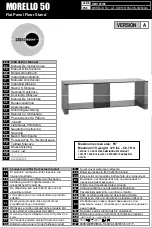
Section 2
– Functional Description
9
FT742-DM (4-20mA)
– Sensors
- User Manual
2.2 Current Loops
2.2.1
Current Loop Characteristics
The wind sensor incorporates two galvanically isolated 4-20mA current loop outputs, one loop for wind speed
and one loop for wind direction. These current loop outputs can be converted into measurable output voltages
with the addition of external resistors.
Each loop should be powered from a DC supply in the range 12V to 30V. A positive supply must be provided to
one of the current loop wires. The other wire must then be connected through a current meter to ground. This is
because the current loops
sink
current, they do
not
source it. A common supply can be used if required. Loop
connections are polarity insensitive so that the +ve or
–ve loop supply connection can be made to either of the
current loop connection pins. See example wiring in Section 4.4.
The current loops are able to operate over long cable distances; however the overall loop resistance should not
exceed the values given in Figure 2. It is recommended that twisted pair interconnection cabling should be
used. The cable should also include an overall braided screen.
Loop Supply
Maximum Loop Resistance
12V
100
Ω
20V
500
Ω
24V
700
Ω
30V
1000
Ω
Figure 2: Maximum Current Loop Resistance
The
wind sensor’s current loop outputs are updated at a rate of 10 times per second. An average of several
readings should always be used for any calculations because single readings can accidentally become
corrupted (see Section 2.2.6).
2.2.2
Using the Averaging Filter
The sensor has an internal averaging filter enabled by default, which dampens the speed and wind direction
outputs by averaging previous data values. By default this feature averages the last 16 readings (1.6s), this can
be factory configured to values 0.1-6.4s in 0.1s increments. It is possible to disable the internal filter (but not
recommended) via the Acu-Test Analogue test software. Contact FT technologies for further details.
Selective Filter
In addition to the averaging filter described above, the sensor has an optional feature called the Selective Filter
that may improve data
quality. The scheme allows the user to set a “validity period”, during which the sensor will
exclude invalid readings from entering the averaging filter. The output will freeze on the last previous “good”
reading and only raise an error flag (see Section 2.2.6) once the number of bad readings exceeds the validity
period. This scheme can be enabled by factory configuration. The filter is turned off by default.
2.2.3
Wind Speed Loop
The default wind speed scaling is such that a change from 4 to 20mA represents 0-75m/s. This corresponds to
a scaling factor of 0.2133mA per m/s. The wind speed scaling factor can be factory programmed to the
customer requirements, contact FT for further details. Figure 3 shows the available wind speed scalings.










































